




placename:- Yordas Cave
 goto source
goto sourceTour to the Caves in the West Riding of Yorkshire, late 18th century
Page 245:- "[at Thornton Church-stile] ... procure a guide, candles, lanthorn, tinder-box, &c. for the purpose of seeing Yordas-Cave, in the vale of Kingsdale, about four miles off. By the advice of a friend, we took also with us a basket of provisions, which we found afterwards were of real service. ..."
 goto source
goto sourcePage 246:- "... we arrived at the object of this excursion, Yordas-cave: it is almost at the top of the vale [Kingsdale], on the north-west side of it, under the high mountain Gragareth. We discovered it by some sheep-folds, at the mouth of a rugged gill or glen, in which we safely pent up our horses. In rainy seasons, we were told, a copious stream is poured down this gill, and a cascade falls over the very entrance into the cave, so as to pre-"
 goto source
goto sourcePage 247:- "[pre]vent any further approach. We were, however, favoured by the weather, and met with no obstacle of that nature to stop our ingress, but boldly entered a large aperture to the left, into the side of the mountain, like the great door of some cathedral. Having never been in the cave before, a thousand ideas, which had been for many years dormant, were excited in my imagination on my entrance into this gloomy cavern. Several passages out of Ovid's Metamorphoses, Virgil, and other classics, crowded into my mind together. At one time I thought it like the den where Cadmus met the huge serpent.-"
"Silva vetus stabet, nulla violata securi; / Est specus in medio virgis ac vimene densus, / Efficiens humilem lapidum compagibus arcum; / Ubericus foecundus aquis. Hoc conditus antro / Martius anguis erat."
"Ovid's Met. b.3. fab.1."
"Within this vale there rose a shady wood / Of aged trees: in its dark bosom stood / A bushy thicket, pathless and unworn, / O'errun with brambles, and perplex'd with thorn; / Amidst the brake a hollow den was found, / With rocks and shelving arches vaulted round; / Deep in the dreary den, conceal'd from day, / Sacred to Mars, a mighty dragon lay."
"Addison."
"Indeed, there wanted nothing but an ancient wood, to make one believe that Ovid had taken from hence his lively description."
"As we advanced within this antre vast, and the gloom and horror increased, the den of Cacus, and the cave of Poliphemus, came into my mind. I wanted nothing but a Sybil conductress with a golden rod, to imagine myself, like Eneas, going into the infernal region. [1] The roof was so high, and"
"[1] See Virgil's Eneid, L.3. l.616 and L.6. l.205. and L.6. l.234"
 goto source
goto sourcePage 248:- "the bottom and sides so dark, that, with all the light we could procure from our candles and torches, we were not able to see the dimensions of this cavern. The light we had, seemed only darkness visible, and would serve a timid stranger, alone, and ignorant of his situation,"
"To conceive things monstrous, and worse / Than fables yet have feign'd, or fear conceiv'd - / Gorgons, and hydras, and chimeras dire."
"Milton."
"The height of the cave was somewhat between a dozen and twenty yards; the breadth about the same dimension with the height; and the length at least fifty or sixty yards. Some of the party, who had seen both, thought it much more stupendous and magnificent than the famous Peak's-hole, in Derbyshire."
"Having passed a small brook, which one of the party called the Stygian lake, we came to the western side of the cave. It is a solid perpendicular rock of black marble, embellished with many rude sketches, and names of persons now long forgotton (sic), the dates of some being above two hundred years old. After we had proceeded thirty or forty yards northward, past some huge rocks that had at sometime fallen from the roof or side, and arrived at a collonade of rude massy pillars, standing obliquely on their bases, the road divided itself into two parts, but not like that of Eneas, when descending in the realms of Pluto -"
"Hac inter Elysium nobis; at loeva malorum / Exercet poenas, et ad impia Tartarus mittit."
"Virgil's En. b.6. l.542."
"'Tis here in different paths the way divides; / The right to Pluto's golden palace guides; / The left to that unhappy region tends, / Which to the depth of Tartarus descends, / The seat of night profound, and punish'd fiends.-"
 goto source
goto sourcePage 249:- "- No; they both had a divine tendency: on the right was the bishop's throne, and on the left the chapter-house - so called from their resemblance to these appendages of a cathedral. Here we could not but lament the devastation made in the ornaments of these sacred places; some Goths, not long since, having defaced both throne and chapter-house of their pendant petrified works, which had been some ages in forming. The little sascades (sic), which fell in various places from the roof and sides with different trilling notes, serving to entertain the ear with their watery music; while the eye was busy in amusing itself with the curious reflections which were made by our lights from the streams and petrifactions which appeared all around us. We were told by our guide, what a great effect the discharge of a gun or pistol would have upon our ears; but not being desirous to carry our experimental philosophy so far as to endanger or give pain to the organs of hearing, we were not disappointed in having no apparatus for that purpose. We followed a winding passage amongst high and grotesque pillars, being led by the noise of a falling stream, till we arrived at the chapter-house. From the dome of this natural edifice fell a fine and clear cascade into a bason of transparent waters, which served in a peculiar manner to embellish the works of nature, in a style superior to any thing we can have in those of art. We were shown a low and narrow passage on one of the shelves of the rock near the chapter-house, which, we were informed, led to a wider path, extending itself into the heart of the mountain; but our curiosity was satisfied without crawling among the rocks besmeared with slime and mud."
"If we had not been cautioned to beware of coming out too suddenly, lest the quick transition from the dreary gloom of the cavern into the glare of sunshine, should injure the sense of seeing, the curiosity for exploring every part in our return, now when our eyes were more opened, was sufficient to retard our steps, and prevent a too hasty egress. While we were regailing sic) ourselves with the provisions we had brought, we enquired of our guide, if he could furnish us with any curious anecdotes relative to this cave. After informing us that it"
 goto source
goto sourcePage 250:- "had been alternately the habitation of giants and fairies, as the different mythology prevailed in the country, he mentioned two circumstances we paid some attention to.- About fifty or sixty years ago, a madman escaped from his friends at or near Ingleton, and lived here a week in the winter season, having had the precaution to take off a cheese, and some other provisions, to his subterranean hermitage. As there was snow on the ground, he had the cunning of Cacus (see Virgil's Eneid, b.8. l.209.) to pull the heels off his shoes, and set them on inverted at the toes, to prevent being traced - an instance, among many others, of a madman's reasoning justly on some detached part of an absurd plan or hypothesis. Since that time, he told us, a poor woman, big with child, travelling alone up this inhospitable vale to that of Dent, was taken in labour, and found dead in this cave."
placename:- Yordas Cave
page 4:- "..."
"THREE VIEWS OF YORDAS CAVE."
"YORDAS CAVE is near the base of the mountain Graygarth, about four miles from Ingleton, on the Dent road, and, crossing over Whernside, two miles from Weathercote."
"ENTRANCE TO YORDAS CAVE. --- The peculiar character of this view is derived from the great masses of rock that hang from the roof, apparently loose, which, combined with the deep gloom of the interior, usually occasion some degree of terror on the first visit to the cave. A few days after this view was drawn, in July 1817, a water-spout burst upon the mountain above, and the torrent occasioned by it forced down great stones and masses of earth, which have half-filled the entrance of the cave. Its present appearance is consequently entirely different from this view, the top not being more than half the height here represented."
"INSIDE OF YORDAS CAVE, LOOKING TOWARDS THE ENTRANCE. --- From the spot where this view was taken, on first entering the cave without torches, nothing can be seen for some time except a glimmering light at the entrance; but as the eye is familiarized with the comparative state of darkness, the forms may be seen very distinctly. Since the flood in 1817 the effect, as represented in this plate, is very much lessened, the stones forced into the cave nearly touching the rock that is pendant from the roof, thereby diminishing the light so much, that the forms can now"
WTL2p05.txt
page 5:- "scarcely be seen without torches. The stream, which runs through the cave for some time disappeared; but the guide, thinking this circumstance diminished the interest of his show, with great labour cleared away the stones and sand from the gully above the cave, and the stream now runs in its original bed. The mass of rock that projects from the right side of the cave is composed entirely of stalactites; in some points of view it is like a stall in a cathedral, with Gothic ornaments above."
"STALACTITES IN YORDAS CAVE. --- The curious forms on the side are excellent specimens of stalactites; one mass that projects beyond the rest is so extremely like the head of a gigantic animal, that it appears to be a work of art. Beyond, in a recess to the right, the sides are covered with these extraordinary petrifactions in the greatest variety of forms."
placename:- Yordas Cave
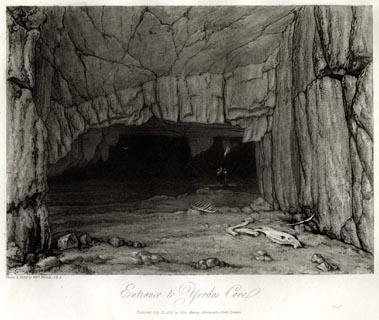 click to enlarge
click to enlargeWTL202.jpg
"Drawn & Etch'd by Willm. Westall A.R.A. / Entrance to Yordas Cave. / Publish'd July 12. 1818. by John Murray, Albemarle Street, London. / Proof"
item:- Armitt Library : A6670.2
Image © see bottom of page
placename:- Yordas Cave
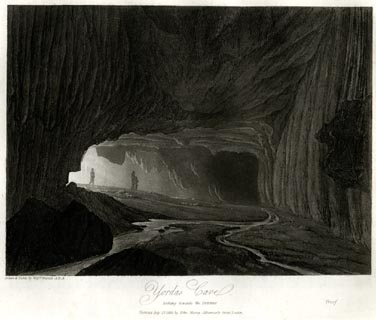 click to enlarge
click to enlargeWTL203.jpg
"Drawn & Etch'd by Willm. Westall A.R.A. / Yordas Cave. / looking towards the Entrance. / Publish'd July 12. 1818. by John Murray, Albemarle Street, London. / Proof"
item:- Armitt Library : A6670.3
Image © see bottom of page
placename:- Yordas Cave
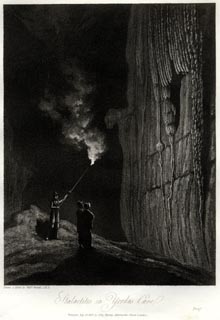 click to enlarge
click to enlargeWTL204.jpg
"Drawn & Etch'd by Willm. Westall A.R.A. / Stalactites in Yordas Cave. / looking towards the Entrance. / Publish'd July 12. 1818. by John Murray, Albemarle Street, London. / Proof"
item:- Armitt Library : A6670.4
Image © see bottom of page
placename:- Yordas
placename:- Yordas Cave
 goto source
goto sourcePage 191:- "..."
"ALL the caves may be visited in progression from Kirkby Lonsdale. To see Yordas, it is necessary to send word to the Guide, who keeps the key of the cavern, which is locked up to prevent the destruction of the petrifactions. Mr. Whittingdale, of Gale Green, Masongill, performs the office of cicerone to Yordas."
"..."
Page 194:-
 click to enlarge
click to enlargeO80E48.jpg
"ENTRANCE TO YORDAS"
item:- Armitt Library : A1180.37
Image © see bottom of page
placename:- Yordas
placename:- Yordas Cave
 goto source
goto sourcePage 193:- "..."
"THE CAVE OF YORDAS - said, in romantic annals, to have been the stronghold of a giant of that name. The nearest route from Easgill to Yordas, is to proceed in a south-easterly direction to the top of Gregareth, the lofty mountain to the right of the Force. On arriving at the summit, desend again in the same line, taking care to look out for a small plantation on your side of the road through Kingsdale, which is in sight. This plantation clothes the rocky banks of a small ravine, down which flows a stream of water, in a succession of small cascades, until it suddenly rushes out of sight,"
 goto source
goto sourcePage 194:- "being swallowed by a large fissure in the rock. At the foot of the ravine, is the entrance into Yordas Cave, forming a regular arch about 7 feet high, and 8 feet wide. On gaining admittance, the guide fixes an ample number of candles upon two cross pieces of wood at the end of a long pole; the vistor, also, takes one in each hand. You then proceed under a low rock, which hangs to within 5 feet of the floor. After proceeding a few"
"yards, the cave seems interminable, as the eye is not quite accustomed to the gloom; and the rushing of a large body of water, reverberating through the hollow space, causes a feeling of awe. A brook runs through the entire length of the cave, which has been called the 'River Styx.' You are now in a magnificent hall, 180 feet long, 48 feet in breadth, and from 35 to 70 feet high; the sides being covered with curious petrifactions. On the east, they are numerous, and give one the idea of escutcheons, armour, and trophies, hung against the"
 goto source
goto sourcePage 195:- "wall of some baron's hall. These are called 'The Brown Bear,' 'The Coat of Mail,' 'The Gauntlet,' 'The Ram's Head,' and 'The Organ;' - and the likeness to these different objects is very striking. The next place is the 'Bishop's Throne,' in the north-east corner. The petrifactions, although of a dusky hue, are remarkably fine, consisting of wreathed pillars, supporting a canopy."
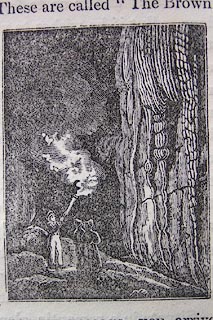 click to enlarge
click to enlargeO80E49.jpg
Inside Yordas Cave
item:- Armitt Library : A1180.38
Image © see bottom of page
placename:- Yordas
placename:- Yordas Cave
 goto source
goto sourcePage 195:- "A little to the left, through a narrow passage, you arrive at the 'Chapter House.' This is the most beautiful portion of the cavern; being a circular apartment, the dome of which is supported by slender twisted columns; the most delicate stalactites hang pendent from the sides; and the north end, a fine cascade falls down a smooth rock, from an elevation of at least 50 feet."
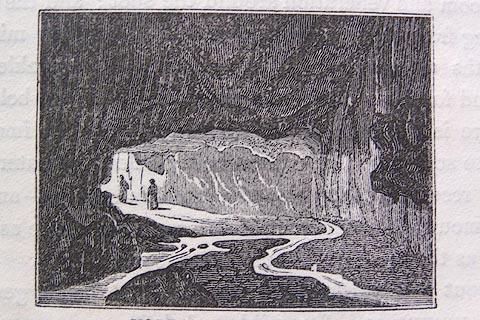 click to enlarge
click to enlargeO80E50.jpg
"YORDAS - LOOKING BACK."
item:- Armitt Library : A1180.39
Image © see bottom of page
placename:- Yordas Cave
placename:- Bishop's Throne
placename:- Chapter House
item:- stalactite
 goto source
goto sourcepage 59:- "..."
"Yordas Cave."
"Turning now from the Ingleborough and Whernside area, and bending our steps up Kingsdale, towards Greygareth, but having first had the precaution to call at Braidey Garth Farm House, a mile lower down the valley, for the key and guide, two shillings being charged for admittance, we find, four miles up the valley, a little plantation, to the left of the road. Turn in here at the gate, and, in the rocks among the trees, the entrance, which is about seven feet high, with a width a trifle greater, will be found. The guide who conducted us had a long pole, on the top of which he placed a coronet of tallow candles, so that the light-shedding instrument could be raised aloft to illumine the dim recesses of the wonderfully spacious cavern - a magnificent cave, ignorantly and grossly libelled in Dr. Whitaker's 'History of Richmondshire,' the libel having been repeated by the author of a local guide-book; thus has the most spacious cave in the district been traduced by those who evidently have never seen it, but"
 goto source
goto sourcepage 60:-
placename:- Yordas Cave
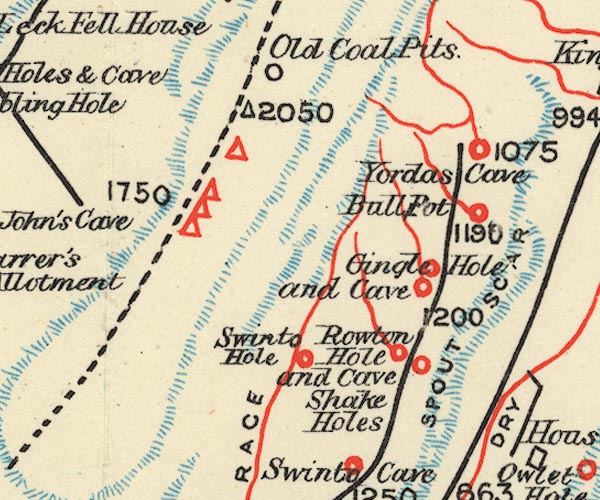
BS1SD67Z.jpg
"Yordas Cave"
item:- private collection : 27.1
Image © see bottom of page
